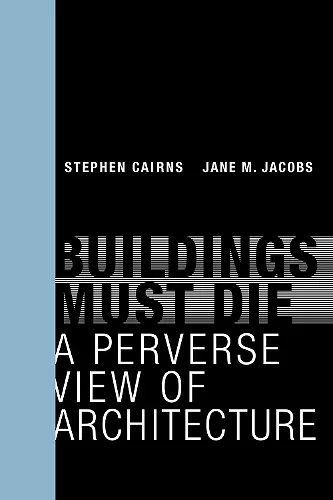Buildings Must Die
A Perverse View of Architecture
Stephen Cairns author Jane M Jacobs author
Format:Paperback
Publisher:MIT Press Ltd
Published:11th Aug '17
Should be back in stock very soon

" Buildings Must Die is indeed a perverse work on architecture, architecture at its most raw and elemental, at the point of its decay and destruction, sometimes quickly, with spectacular effect, and sometimes slowly. Architecture is never fully living, and is always passing out of existence; as it makes, so what it makes is inevitably unmade. This book is a fascinating, articulate exploration of this movement of creative destruction that haunts the very project of architecture. -- Elizabeth Grosz, author of Architecture from the Outside Buildings rot. Buildings decay. Buildings die. But this sense of buildings' mortality can be a positive force, as Cairns and Jacobs illustrate so well. Out of the rubble, they have created a book of immense significance not just for the practitioners and theorists of architecture but for anyone who is interested in the ecology of habitation. -- Nigel Thrift,, Vice-Chancellor, University of Warwick Buildings Must Die offers case studies and meditations upon architectural ends in the tradition of Neil Harris's Building Lives and Karsten Harries's The Ethical Function of Architecture. Yet Buildings Must Die is also uniquely life-affirming, showing practitioners how "death and waste can play their parts in architectural creativity." -- Daniel M. Abramson, Associate Professor, Tufts University, and author of Building the Bank of England: Money, Architecture, Society, 1694-1942 Of all the versions of the body-building analogy -- from Vitruvius to Alberti, Le Corbusier, Aldo van Eyck, and architects today -- few, if any, have invoked mortality as the term of comparison, as Stephen Cairns and Jane Jacobs do in Buildings Must Die. New conceptions of architectural order result from this approach: deformation is not devaluation, permanence involves perpetual perishing, and duration depends on alteration. Historically significant themes such as ruin and weathering are discussed, also topics that are particularly relevant today: disaster, demolition, and waste. A fuller understanding of endings emerges, which in turn leads to a profound reconsideration of beginnings, and thus of architecture itself. -- David Leatherbarrow, Professor of Architecture, University of Pennsylvania, and author of Uncommon Ground: Architecture, Technology, and Topography
Part memento mori for architecture, and part invocation to reimagine the design values that lay at the heart of its creative purpose.
Part memento mori for architecture, and part invocation to reimagine the design values that lay at the heart of its creative purpose.
Buildings, although inanimate, are often assumed to have "life." And the architect, through the act of design, is assumed to be their conceiver and creator. But what of the "death" of buildings? What of the decay, deterioration, and destruction to which they are inevitably subject? And what might such endings mean for architecture's sense of itself? In Buildings Must Die, Stephen Cairns and Jane Jacobs look awry at core architectural concerns. They examine spalling concrete and creeping rust, contemplate ruins old and new, and pick through the rubble of earthquake-shattered churches, imploded housing projects, and demolished Brutalist office buildings. Their investigation of the death of buildings reorders architectural notions of creativity, reshapes architecture's preoccupation with good form, loosens its vanities of durability, and expands its sense of value. It does so not to kill off architecture as we know it, but to rethink its agency and its capacity to make worlds differently.
Cairns and Jacobs offer an original contemplation of architecture that draws on theories of waste and value. Their richly illustrated case studies of building "deaths" include the planned and the unintended, the lamented and the celebrated. They take us from Moline to Christchurch, from London to Bangkok, from Tokyo to Paris. And they feature the work of such architects as Eero Saarinen, Carlo Scarpa, Cedric Price, Arata Isozaki, Rem Koolhaas and François Roche.
Buildings Must Die is both a memento mori for architecture and a call to to reimagine the design values that lay at the heart of its creative purpose.
Imagine a book on world leaders that looks at how they died, rather than their accomplishments, for an explanation of why the book's subtitle acknowledges that this perspective is 'perverse'. Despite and perhaps even because of these quirks, Buildings Must Die has the freshness of a project that takes a field and turns it on its head—or, perhaps, blows it up.
* Times Higher EducatiISBN: 9780262534710
Dimensions: 229mm x 152mm x 24mm
Weight: unknown
312 pages